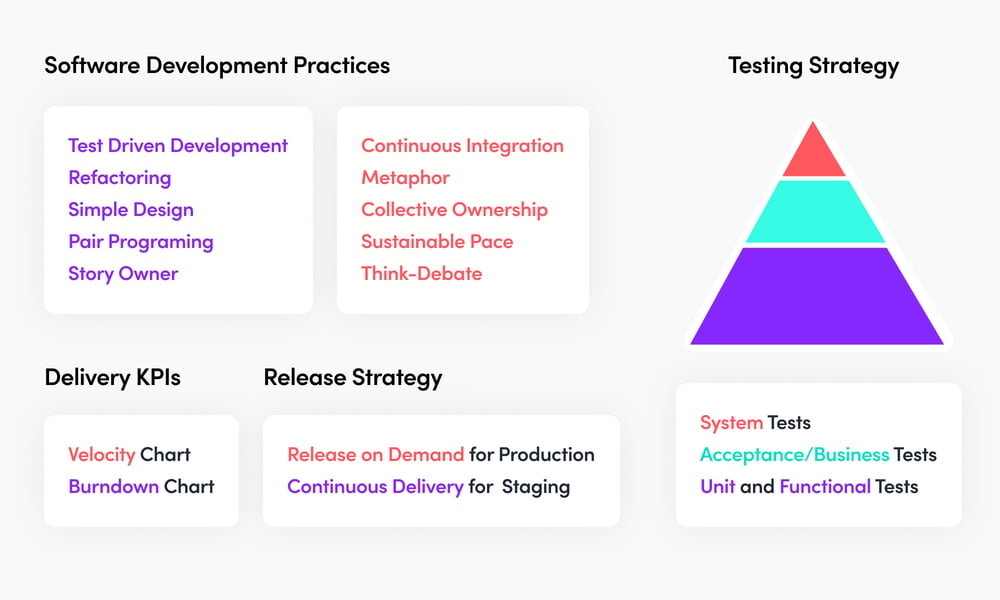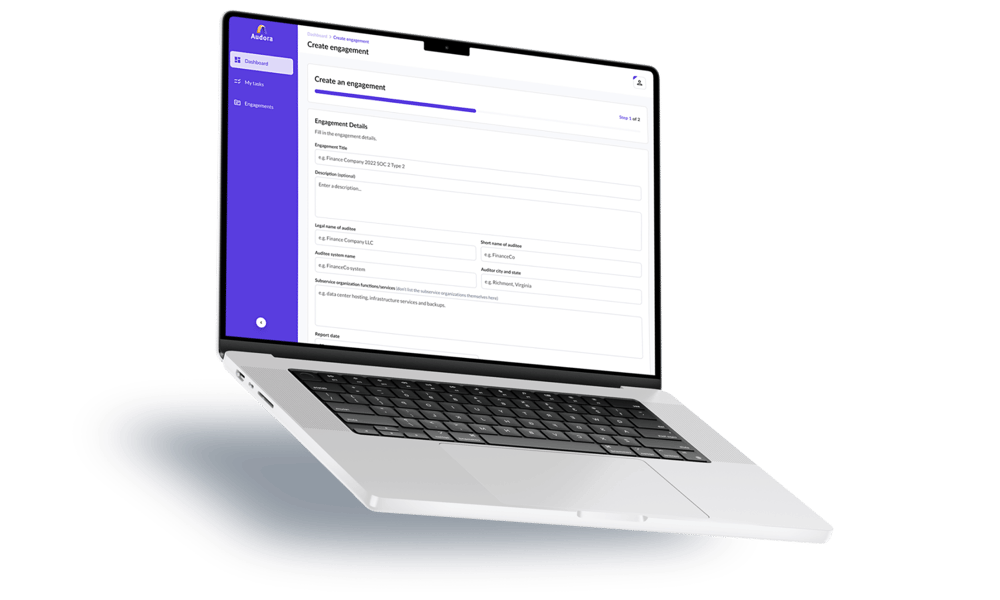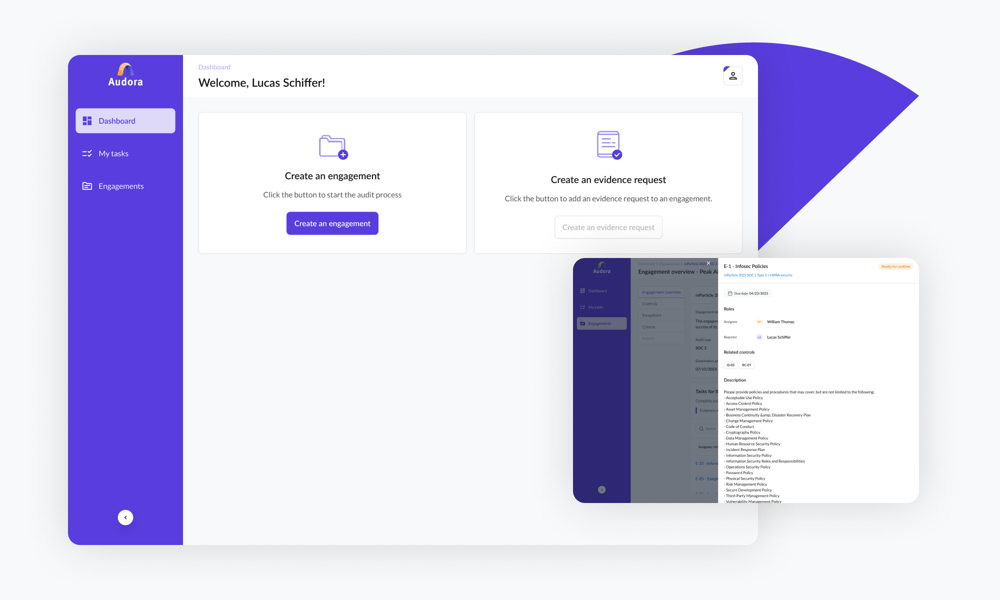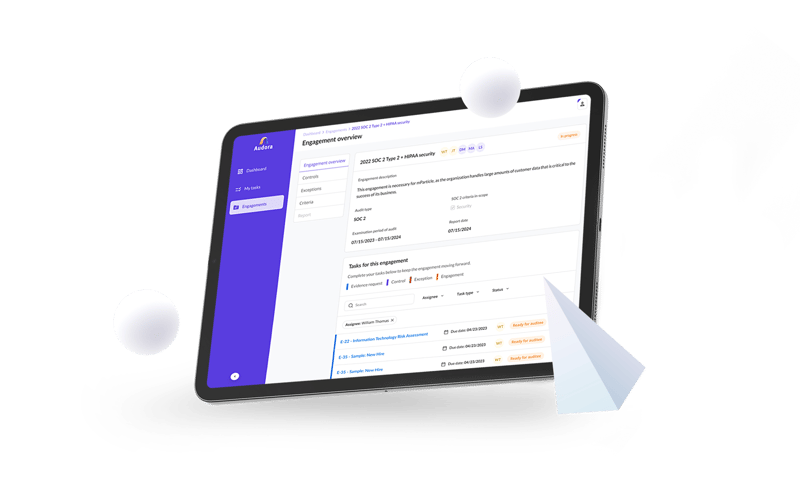Approach to building the Audora MVP: needs analysis, timeline & methodology
Following a deep understanding of market challenges and client requirements, our solution was to help the client build a web platform that automates manual processes associated with audit processes. Over the course of six months (February - October 2023), a team was assigned to work on creating the Audora MVP.
Needs and benefits analysis
During Phase 1, our goal was to understand client needs and requirements for the Audora MVP, as well as the benefits the product would provide. Together with the client, we identified that the Audora platform had to be:
- Easy to learn and use by auditors and auditees
- Equipped to optimize every stage of the audit lifecycle
- Fully automated and ready to remove manual, repeatable tasks
- Time-efficient
After establishing the needs and requirements for the MVP, the estimated time to market for the release was established at 5 months.

How did success look like in this current massive phase?
In this phase, our primary focus was precision rather than market speed. However, we take pride in successfully developing a complex and functional MVP within the designated timeframe and estimated budget. As a result, the Audora web platform is now fully operational and ready for use by at least one client.
Development timeline
For Phase 2, a multi-disciplinary team of people (project manager, product lead, software development lead, UI/UX Design lead, 4 x Frontend Software Engineers, 3 x Backend Software Engineers, QA Automation Engineer, and Key Account Manager) was assigned to work on building the Audora MVP.
Together, we decided to divide the product roadmap into three main stages:
- Sprint 0 was focused on setting up the infrastructure. We worked on defining processes and ways of working, tools, and communication setup.
- MVP development
- Preparations for post-MVP development, including user testing, feature clarifications, and prioritization of new features.
Methodology
Following the development timeline and product roadmap, we had to determine the most suitable software development practices and establish reliable delivery KPIs.
We prioritized a holistic approach that included Test-driven development, Refactoring, and Simple Design principles. To enhance code quality, we chose Pair Programming as a collaborative technique. It helped us foster better communication, shared knowledge, and faster issue resolution, ultimately ensuring efficient development cycles and easier delivery of the main KPIs.
Throughout development, we monitored our progress using Velocity Chart and Burndown Chart as key metrics. These delivery KPIs helped us deliver valuable insights into our team's performance while staying on track to meet project milestones efficiently.
For our code release strategy, we adopted continuous delivery for the Staging environment. It streamlined the testing and validation process, allowing team members to catch and address issues early in the development pipeline. This approach ensured that the code was thoroughly tested and validated in a production-like environment before being released to users, reducing the risk of introducing defects into the live system.
For the Production environment, we went with Release on demand. The testing strategy included, from beginning to end, System Tests, Acceptance/Business Tests, and Unit and Functional Tests.

Tech stack implementation
A decision was made to implement a serverless infrastructure on top of Amazon Web Services (AWS). This decision was based on the proficiency of our developers with the vast range of services offered by AWS and on Audora’s previous experience with AWS.
On a scale from 1 (easy) to 5 (hard), we rated the cost of changing the infrastructure at a 4 due to the following reasons:
- It required the implementation of a new Infrastructure Design
- It required the implementation of new adaptors for the external layers (delivery layer, database layer, file system layer, networking layer, etc)
- It required data migration between databases and file systems
However, it didn’t require any code rewrite or migration, which was an important reason for choosing to go with AWS.

To implement the API Application, Node.js was used as the runtime environment and TypeScript as the programming language. Regarding code repository, our team chose Github it offered robust version control, collaboration tools, and a user-friendly interface, making it ideal for our development needs.
UI/UX deliverables
In terms of UI/UX, our goal was to craft a seamless yet easy user experience. For Audora, the journey began with the creation of proto-personas, which gave us invaluable guidance throughout the design process.
We mapped out the user's journey, ensuring every interaction has meaning. The visual UI style guide, including typography, color palette, and UI elements, established a consistent and visually appealing interface. High-fidelity prototypes brought our core use cases to life, ensuring the end product was both functional and engaging for the end user.
Key UI/UX deliverables included:
- Proto-personas definition for guidance in the user experience
- User Journey flowchart
- Low-fidelity wireframes and further prototypes
- Visual UI style guide (Typography, Color Paletter, UI elements)
- High-fidelity prototypes (core use cases)

MVP launch outcomes: productivity gains, budget adherence, first clients onboarded
Due to our team’s dedication to the project and hands-on expertise in building exceptional digital products the Audora MVP was released on time and within the estimated budget. This allows the client to carry out further initiatives planned for October 2023 - sending the MVP to the first batch of clients and integration with leading security and compliance platforms.









